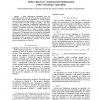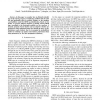PAMI
2012
12 years 9 months ago
2012
Which one comes first: segmentation or recognition? We propose a unified framework for carrying out the two simultaneously and without supervision. The framework combines a fle...
STTT
2011
14 years 2 months ago
2011
We present algorithms for parallel probabilistic model checking on general purpose graphic processing units (GPGPUs). Our improvements target the numerical components of the tradit...
106
click to vote
AR
2011
14 years 2 months ago
2011
This paper presents a novel method for learning object manipulation such as rotating an object or placing one object on another. In this method, motions are learned using referenc...
IJKESDP
2010
14 years 4 months ago
2010
Cognitive Agents must be able to decide their actions based on their recognized states. In general, learning mechanisms are equipped for such agents in order to realize intellgent ...
EMNLP
2009
14 years 5 months ago
2009
The work presented in this paper explores a supervised method for learning a probabilistic model of a lexicon of VerbNet classes. We intend for the probabilistic model to provide ...
CEC
2009
IEEE
14 years 5 months ago
2009
IEEE
-- Most optimization algorithms that use probabilistic models focus on extracting the information from good solutions found in the population. A selection method discards the below...
QEST
2010
IEEE
14 years 5 months ago
2010
IEEE
Adaptive techniques like voltage and frequency scaling, process variations and the randomness of input data contribute signi cantly to the statistical aspect of contemporary hardwa...
INFOCOM
2010
IEEE
14 years 5 months ago
2010
IEEE
In this paper we consider how to efficiently identify tags on the moving conveyor. Considering conditions like the path loss and multi-path effect in realistic settings, we first p...
SDM
2010
SIAM
14 years 5 months ago
2010
SIAM
In this paper, we consider the problem of community detection in directed networks by using probabilistic models. Most existing probabilistic models for community detection are ei...
OR
2007
Springer
14 years 6 months ago
2007
Springer
The Maximal Covering Location Problem (MCLP) maximizes the population that has a facility within a maximum travel distance or time. Numerous extensions have been proposed to enhan...





